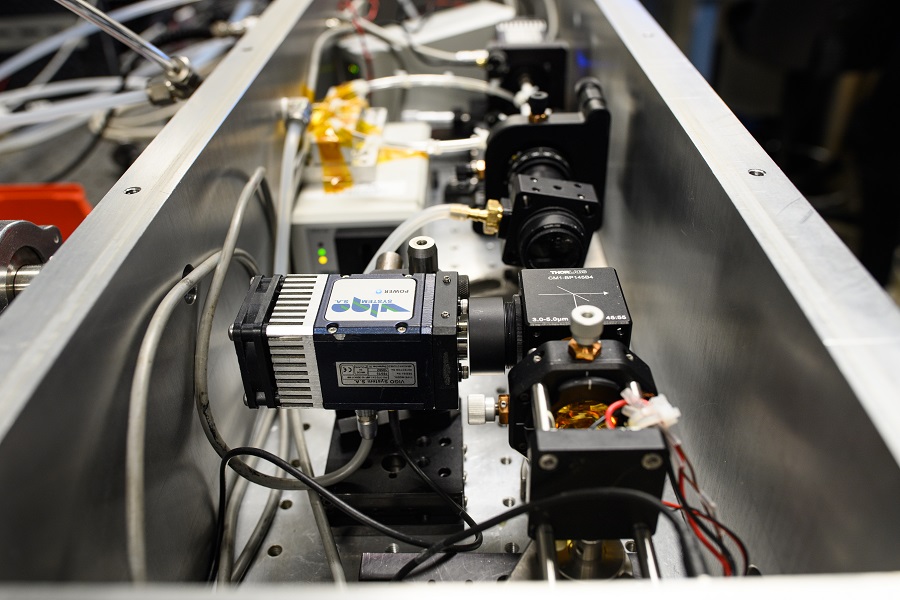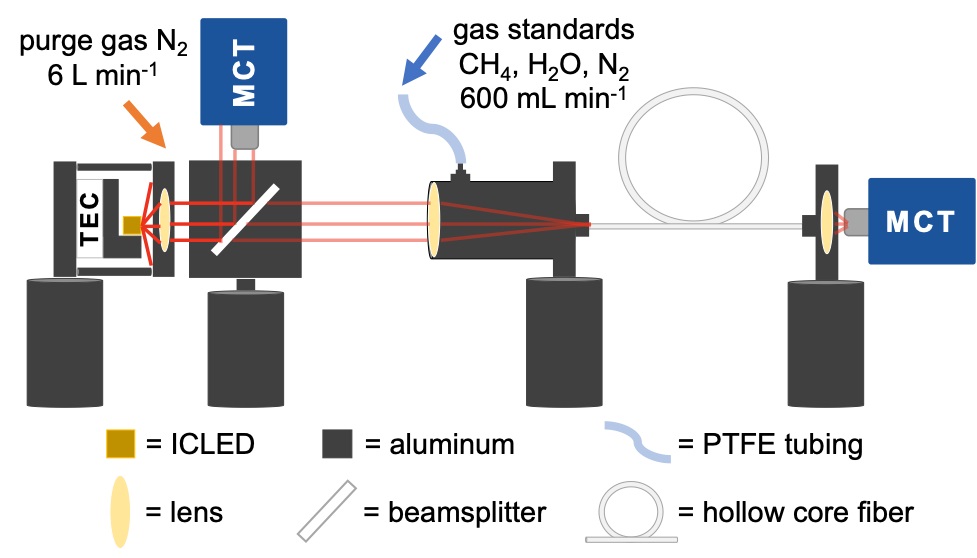About
22 February 2021
New Sensor Paves Way to Low-cost Sensitive Methane Measurements
Recent advances could make it feasible to deploy networks of methane sensors to detect this greenhouse gas at large facilities
WASHINGTON — Researchers have developed a new sensor that could allow practical and low-cost detection of low concentrations of methane gas. Measuring methane emissions and leaks is important to a variety of industries because the gas contributes to global warming and air pollution.
“Agricultural and waste industries emit significant amounts of methane,” said Mark Zondlo, leader of the Princeton University research team that developed the sensor. “Detecting methane leaks is also critical to the oil and gas industry for both environmental and economic reasons because natural gas is mainly composed of methane.”

Caption: Researchers have developed a new sensor that uses an interband cascade light emitting device (ICLED) and could allow practical and low-cost detection of low concentrations of methane.
Credit: Sameer A. Khan/Fotobuddy
In The Optical Society (OSA) journal Optics Express, researchers from Princeton University and the U.S. Naval Research Laboratory demonstrate their new gas sensor, which uses an interband cascade light emitting device (ICLED) to detect methane concentrations as low as 0.1 parts per million. ICLEDs are a new type of higher-power LED that emits light at mid-infrared (IR) wavelengths, which can be used to measure many chemicals.
“We hope that this research will eventually open the door to low-cost, accurate and sensitive methane measurements,” said Nathan Li, first author of the paper. “These sensors could be used to better understand methane emissions from livestock and dairy farms and to enable more accurate and pervasive monitoring of the climate crisis.”
Building a less expensive sensor
Laser-based sensors are currently the gold standard for methane detection, but they cost between USD 10,000 and 100,000 each. A sensor network that detects leaks across a landfill, petrochemical facility, wastewater treatment plant or farm would be prohibitively expensive to implement using laser-based sensors.
Although methane sensing has been demonstrated with mid-IR LEDs, performance has been limited by the low light intensities generated by available devices. To substantially improve the sensitivity and develop a practical system for monitoring methane, the researchers used a new ICLED developed by Jerry Meyer’s team at the U.S. Naval Research Laboratory.
“The ICLEDs we developed emit roughly ten times more power than commercially available mid-IR LEDs had generated, and could potentially be mass-produced,” said Meyer. “This could enable ICLED-based sensors that cost less than USD 100 per sensor.”

Caption: To boost sensitivity, infrared light from the high-power ICLED travels through a 1-meter-long, hollow-core fiber containing an air sample. The inside of the fiber is coated with silver, which causes the light to reflect off its surfaces as it travels down the fiber to the photodetector (MCT for HgCdTe detector) at the other end. This allows the light to interact with additional molecules of methane in the air resulting in higher absorption of the light.
Credit: Nathan Li, Princeton University
To measure methane, the new sensor measures infrared light transmitted through clean air with no methane and compares that with transmission through air that contains methane. To boost sensitivity, the researchers sent the infrared light from the high-power ICLED through a 1-meter-long hollow-core fiber containing an air sample. The inside of the fiber is coated with silver, which causes the light to reflect off its surfaces as it travels down the fiber to the photodetector at the other end. This allows the light to interact with additional molecules of methane in the air resulting in higher absorption of the light.
“Mirrors are commonly used to bounce light back and forth multiple times to increase sensor sensitivity but can be bulky and require precise alignment,” said Li. “Hollow core fibers are compact, require low volumes of sample gas and are mechanically flexible.”
Measuring up to laser-based sensors
To test the new sensor, the researchers flowed known concentrations of methane into the hollow core fiber and compared the infrared transmission of the samples with state-of-the-art laser-based sensors. The ICLED sensor was able to detect concentrations as low as 0.1 parts per million while showing excellent agreement with both calibrated standards and the laser-based sensor.
“This level of precision is sufficient to monitor emissions near sources of methane pollution,” said Li. “An array of these sensors could be installed to measure methane emissions at large facilities, allowing operators to affordably and quickly detect leaks and mitigate them.”
The researchers plan to improve the design of the sensor to make it practical for long-term field measurements by investigating ways to increase the mechanical stability of the hollow-core fiber. They will also study how extreme weather conditions and changes in ambient humidity and temperature might affect the system. Because most greenhouse gases, and many other chemicals, can be identified by using mid-IR light, the methane sensor could also be adapted to detect other important gases.
Paper: N. Li, L. Tao, H. Yi, C. S. Kim, M. Kim, C. L. Canedy, C. D. Merritt, W. W. Bewley, I. Vurgaftman, J. R. Meyer, M. A. Zondlo, “Methane detection using an interband-cascade LED coupled to a hollow-core fiber,” Opt. Express, 29, 5, 7221-7231 (2021).
DOI: https://doi.org/10.1364/OE.415724
About Optica Publishing Group
Optica Publishing Group is a division of the society, Optica, Advancing Optics and Photonics Worldwide. It publishes the largest collection of peer-reviewed and most-cited content in optics and photonics, including 18 prestigious journals, the society’s flagship member magazine, and papers and videos from more than 835 conferences. With over 400,000 journal articles, conference papers and videos to search, discover and access, our publications portfolio represents the full range of research in the field from around the globe.
About Optics Express
Optics Express reports on scientific and technology innovations in all aspects of optics and photonics. The bi-weekly journal provides rapid publication of original, peer-reviewed papers. It is published by Optica Publishing Group and led by Editor-in-Chief James Leger of the University of Minnesota, USA. Optics Express is an open-access journal and is available at no cost to readers online. For more information, visit Optics Express.
About The Optical Society
The Optical Society (OSA) is dedicated to promoting the generation, application, archiving, and dissemination of knowledge in optics and photonics worldwide. Founded in 1916, it is the leading organization for scientists, engineers, business professionals, students, and others interested in the science of light. OSA’s renowned publications, meetings, online resources, and in-person activities fuel discoveries, shape real-life applications and accelerate scientific, technical, and educational achievement.
About Optics Express
Optics Express reports on scientific and technology innovations in all aspects of optics and photonics. The bi-weekly journal provides rapid publication of original, peer-reviewed papers. It is published by Optica Publishing Group and led by Editor-in-Chief James Leger of the University of Minnesota, USA. Optics Express is an open-access journal and is available at no cost to readers online. For more information, visit Optics Express.
Media Contact
